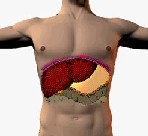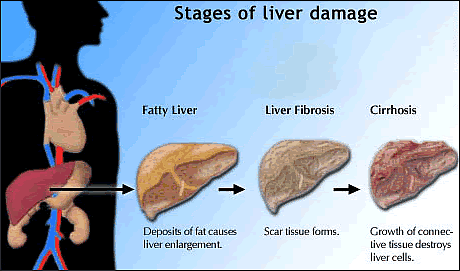| Liver
Fibrosis Progression in HIV-HCV Coinfected Individuals By
Liz Highleyman
 Prior
studies have indicated that HIV
positive individuals coinfected with hepatitis C virus (HCV) tend to experience
more rapid and more severe liver disease progression than HIV negative people
with HCV alone. Data are mixed, however, and
some evidence suggests that HIV-HCV
coinfected patients with well-preserved immune function and a high CD4 cell
count may fare as well as HCV monoinfected individuals. Prior
studies have indicated that HIV
positive individuals coinfected with hepatitis C virus (HCV) tend to experience
more rapid and more severe liver disease progression than HIV negative people
with HCV alone. Data are mixed, however, and
some evidence suggests that HIV-HCV
coinfected patients with well-preserved immune function and a high CD4 cell
count may fare as well as HCV monoinfected individuals. Two
presentations at the 59th Annual Meeting of the American
Association for the Study of Liver Diseases (AASLD 2008) this week in San
Francisco shed further light on
fibrosis progression in coinfected individuals.
Fibrosis
and Inflammation Progression
Richard
Sterling from Virginia Commonwealth University and colleagues conducted a prospective,
longitudinal evaluation of paired liver biopsies to assess histological disease
progression in a cohort of coinfected patients.
Out of 261 HIV-HCV coinfected
individuals who underwent an initial biopsy
between 1998 and 2008 at their institution, 47 patients without baseline cirrhosis
had at least 2 paired biopsies and were included in the present analysis. Individuals
with hepatitis B, heavy alcohol use, or other
causes of liver disease were excluded.
Demographic characteristics reflected
those of the HIV positive population. Most (70%) were men, 77% were African-American,
and the mean age was 42 years. Participants had well-controlled HIV disease, with
a mean CD4 count of about 600 cells/mm3. About 80% were on HAART
and nearly half had HIV RNA < 400 copies/mL.
Almost all participants
(95%) had HCV genotype 1
and about one-third had received interferon-based
treatment for chronic hepatitis C; within the latter group, about 25% were
non-responders, 2% experienced relapse, and 6% achieved sustained
virological response.
Clinical and laboratory data were obtained at
the time of biopsy and every 3-6 months thereafter. The mean interval between
biopsies was 52 months (about 4 years). Liver histology was assessed using Ishak
scores for inflammation (scale of 0-18) and fibrosis
(scale of 0-6). Steatosis
(fat accumulation in liver cells) and cytologic ballooning were also assessed. 
Results
•
At baseline, the average inflammation
score was 6.4, the average fibrosis scores was 1.5, and 24% of patients had steatosis
affecting > 5% of liver cells.
•
Between the first and second biopsies,
the following changes were observed:
•
34% of patients experienced fibrosis progression
(21% by < 2 points, 13% by > 2 points).
•
44% had unchanged fibrosis;
•
21% experienced fibrosis regression or
improvement (19% by < 2 points, 2% by > 2 points).
•
Changes in inflammation were as follows:
•
55% experienced worsened inflammation
(13% by < 2 points, 42% by > 2 points).
•
15% had unchanged inflammation.
•
29% experienced an improvement in inflammation
(8% by < 2 points, 21% by > 2 points).
•
The annual man rate of fibrosis progression
was 0.132 units per year.
•
The annual mean inflammation progression
rate was 0.174 units/year.
•
There was no observed association between
liver disease progression and any of the following factors:
•
Patient demographics (sex, race, age);
•
AST or ALT level;
•
CD4 cell count;
•
HIV viral load;
•
Overall use of HAART;
•
Specific use of stavudine
(d4T; Zerit) and didanosine (ddI;
Videx);
•
Use of or response to anti-HCV therapy;
•
Baseline FIB-4 (an non-invasive index
of biochemical markers of fibrosis);
•
Baseline liver histology including inflammation,
fibrosis, or steatosis.
These
findings led the investigators to conclude, "Significant fibrosis progression
(> 2 points) occurred in 13%, and 42% had significant increase in inflammation
after a mean interval of 52 months."
"No single factor was predictive
of worsening histology," they added. "Therefore, biopsy is required
to identify those individuals who have liver disease progression."
In
the discussion following the presentation, it was noted that researchers at Johns
Hopkins University reported that the rate of significant fibrosis in their HIV-HCV
coinfected cohort was about twice as high (25%) as the 13% rate reported here.
Dr. Sterling said he could not explain the disparity.
Even though the fibrosis
rate in the present study was relatively low, he still recommended that motivated
coinfected patients should receive anti-HCV treatment, given that it was impossible
at this time to predict which ones would progress.
Virginia Commonwealth
University, Richmond, VA.
Normal
ALT In
a second study, C. Sagnelli and colleagues assessed liver disease outcomes among
HIV-HCV coinfected patients with persistently normal ALT. ALT
(alanine aminotransferase) is an enzyme that indicates liver inflammation. It
is often elevated in people with active viral hepatitis, drug-induced hepatoxicity,
or other conditions that damage the liver. However, ALT does not necessarily reflect
fibrosis, and some people with chronic hepatitis C sustain significant liver disease
progression with persistently normal ALT levels.
The Italian investigators
studied 34 HIV-HCV coinfected patients with 9 normal aminotransferase level tests
over 18 months who underwent liver biopsies. Outcomes in this group were compared
with those of 30 HCV monoinfected individuals with persistently normal ALT who
received biopsies during the same period.
At the time of liver biopsy,
29 of 34 patients in the former group were on HAART. Overall, this group had well-controlled
HIV disease, with a mean CD4 count of about 560 cells/mm3, but just over half
had a CD4 cell nadir (lowest-ever level) of 200 cells/mm3 or less. HIV-HCV coinfected
individuals were more likely than HCV monoinfected patients to be male (62% vs
43%), to be injection drug users (77% vs 0%), and to be infected with HCV genotypes
3 (38% vs 0%) or 4 (29% vs 0%). None had received hepatitis C treatment prior
to biopsy.
Liver biopsies were analyzed for histological activity index
(HAI), fibrosis, and steatosis using the Ishak scoring system by a pathologist
unaware of clinical and laboratory data. Several types of microlesions (e.g.,
acidophil bodies, lymphoid follicles, rhomboid hepatocytes, Mallory bodies, germinal
centers, etc.) were recorded as present or absent.
Results
•
The HAI score was < 8 in the majority
of patients in both the HIV-HCV coinfected and HCV monoinfected groups (91% vs
97%).
•
The fibrosis score, however, was significantly
higher in the HIV-HCV coinfected group compared with the HCV monoinfected group
(mean 2.1 vs 1.4; P < 0.05).
•
24% of coinfected patients had a fibrosis
score of 3-6, compared with 7% of HCV monoinfected individuals (P < 0.05).
•
32% of coinfected patients had a high
degree of steatosis (scores of 3-4) compared with just 3% of HCV monoinfected
individuals (P < 0.005).
•
Analysis of liver microlesions, however,
did not reveal statistically significant differences between the2 groups.
Based
on these findings, the researchers concluded, "The data indicate that both
HIV-HCV coinfected and HCV monoinfected patients with [persistently normal ALT]
show a low degree of necroinflammation."
"Patients with HIV-HCV
coinfection frequently show moderate or high liver fibrosis and deserve anti-HCV
treatment," they added.
The investigators suggested that the higher
degree of cirrhosis in the coinfected group might be attributable to HAART toxicity
or to the higher prevalence of HCV genotype 3.
Second University of
Naples, Naples, Italy; San Raffaele Hospital, Milan, Italy.
11/07/08
References
RK
Sterling, PG Smith, J Wegelin, and others. Prospective evaluation by paired liver
biopsy of HCV disease progression in patients (pts) co-infected with HIV. 59th
Annual Meeting of the American Association for the Study of Liver Diseases (AASLD
2008). San Francisco. October 31-November 4, 2008. Abstract 27/1931. C
Sagnelli, C Uberti-Foppa, L Galli, and others. Liver Histology in HIV/HCV Coinfected
Patients with Persistently Normal Serum Aminotransferases. 59th Annual Meeting
of the American Association for the Study of Liver Diseases (AASLD 2008). San
Francisco. October 31-November 4, 2008. Abstract 502. |

![]()
 Prior
studies have indicated that
Prior
studies have indicated that 